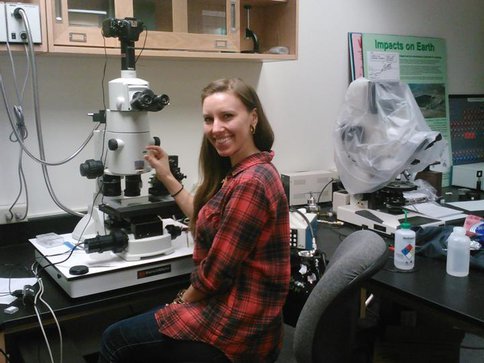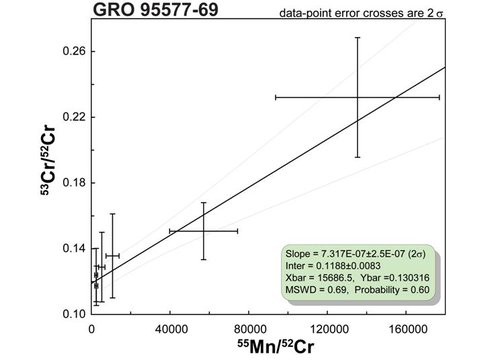2012 Annual Science Report
 University of Hawaii, Manoa
Reporting | SEP 2011 – AUG 2012
University of Hawaii, Manoa
Reporting | SEP 2011 – AUG 2012
Aqueous Alteration of CR Chondrites
Project Summary
Petrologic studies of chondrites have shown that many samples contain hydrated minerals that are formed by aqueous alteration of primitive components. Through this discovery, it has become clear that the action of water played a key role in geologic processes of the early Solar System. CR chondrites – a subclass of carbonaceous chondrites – display a range of mineralogy from practically anhydrous (type 3) to completely hydrated (type 1). In addition, CRs show minimal evidence for thermal metamorphism that overprints or obscures aqueous alteration signatures. Knowledge of the aqueous alteration in CR chondrites will yield important interpretations on how, and to what extent, water affected the geologic evolution of primary nebular components, with implications that extend to how and where life began to evolve in the Solar System. A particularly important issue is how aqueous alteration affected the initial set of organic compounds present in carbonaceous chondrites. Amino acids (the building blocks of life) are a class of organic molecule present in meteorites. Understanding how or if organic molecules form on meteorites and their interactions with the water in meteorites has important implications for the chemical inventory of the meteorites, the process by which life formed on our planet, and the possibility that life can form on other planets in our Solar System. We are using a suite of micro analytical tools to understand the early solar system aqueous environment and production or organic material.
Project Progress
Over the course of the past year, the aqueous alteration project has sustained substantial progress. We have requested and received meteorite thin sections from the Johnson Space Center through the Meteorite Working Group, including some rare samples of type CR1 (GRO95577) and CR3 (MET00426 and QUE99177). Through the use of various micro-analytical tools (such as the Scanning Electron Microscope and Electron Microprobe) we have located areas of secondary (aqueous) alteration in our sample thin sections. False-color elemental X-ray maps have been useful in identification of distinct lithologies, which likely were formed under various conditions on the CR parent body. Quantitative elemental analysis of minerals has helped to identify phase assemblages that formed under distinct aqueous environments. To gain further understanding of the CR aqueous alteration environment, we have utilized Geochemist Workbench software for fluid chemistry modeling. These models have helped to constrain parameters such as pH and oxygen fugacity during fluid events that led to secondary mineral formation. Progress in this modeling work was presented in a talk at the 75th Annual Meeting of the Meteoritical Society in August 2012.
Secondary carbonates have been identified in the CR thin sections, and are excellent candidates for manganese-chromium radiometric dating using Secondary Ion Mass Spectrometry (SIMS). The Mn-Cr radiochronometer system can resolve aqueous events occurring up to around 20Myr after the formation of CAIs. However, a historic problem with measurements has been finding appropriate standards. Current progress is being made on the development/acquisition of carbonate mineral standards so that anticipated measurements yield valid isochrons.
In our studies of organic compounds, we are working on a suite of techniques that will allow us to more easily detect organic molecules in situ in aqueously altered carbonaceous meteorites. With the help of our collaborators Shiv Sharma and Anupam Misra, we are developing a time-resolved laser-induced fluorescence instrument dubbed “biofinder.” The biofinder instrument uses a pulsed green or UV laser and an intensified CCD camera designed to separate the short-lived fluorescence, usually attributable to bio-organic molecules or biosignatures, from long-lived fluorescence, attributable to minerals. The fluorescence images are collected in real time. Hence, the biofinder can be used as a field instrument to find interesting targets for closer study. Unfortunately, the biofinder cannot directly measure another very important class of organic materials in meteorites, macromolecular kerogen-like material known as insoluble organic material (IOM). We are developing a technique called Imaging Raman Microscopy to quickly map parts of our meteorite samples that we suspect contain IOM. Imaging Raman Microscopy is an established technique that uses a laser and a microscope with a moving stage to collect high spatial resolution spectral images of samples. We use a computer program to process the raw data and give us a set of spectral parameters that can describe the IOM. Using a combination of the biofinder and the Raman Imager, we can get a full picture of the distribution of organic molecules present in our meteorite samples. Initial results were presented in a talk at the 75th Annual Meeting of the Meteoritical Society in August 2012 and a poster at the 43rd Lunar and Planetary Science Conference in March 2012.
Graduate student and UHNAI team-member Christine Jilly uses a light-microscope to detect terrestrial contamination within this rare (type CR3) meteorite sample. In subsequent analyses, Christine will use a scanning electron microscope and an ion microprobe to gather precise measurements of the meteorite’s mineralogy, wherever it is pristine (uncontaminated), to better understand the processes by which extraterrestrial liquid water and heat cause mineral evolution. The CR3 class of meteorites are especially useful to astrobiological studies because, as a class, they contain widely varying regions that have experienced different degrees of thermal and aqueous alteration during their voyage to Earth.
Manganese-Chromium isochron from isotopic measurements of carbonates in GRO 95577, a CR1 chondrite. The slope of the line corresponds to an initial ratio of (53Mn/55Mn) = 7.3 × 10^-7. This implies that the secondary minerals were formed by aqueous alteration nearly 15 Myr after the formation of the solar system.
-
PROJECT INVESTIGATORS:
-
PROJECT MEMBERS:
Patrick Gasda
Project Investigator
Christine Jilly
Project Investigator
Gary Huss
Co-Investigator
Sasha Krot
Co-Investigator
Anupam Misra
Collaborator
Kazuhide Nagashima
Collaborator
Shiv Sharma
Collaborator
-
RELATED OBJECTIVES:
Objective 1.1
Formation and evolution of habitable planets.
Objective 3.1
Sources of prebiotic materials and catalysts

